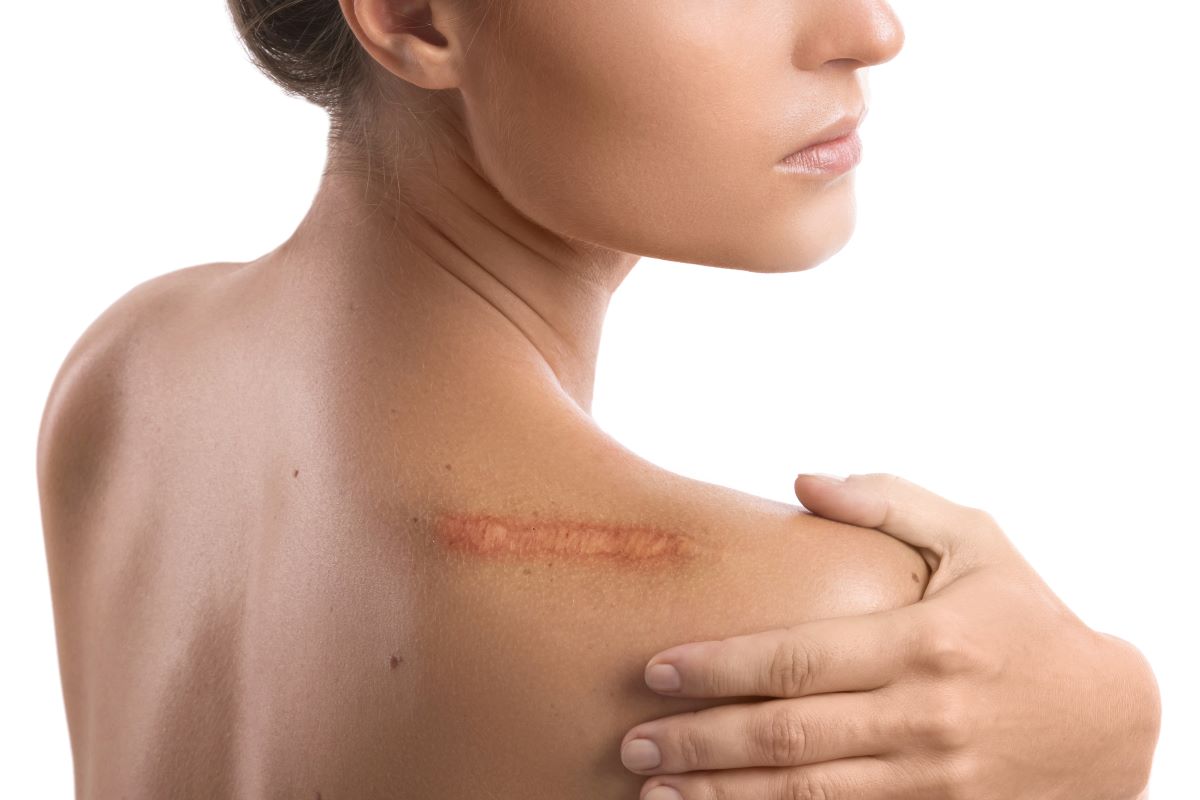
Keloid Scarring
A keloid scar is a lumpy, raised, overgrown scar that can sometimes develop when a wound heals, or even after very minor skin damage such as acne.
Keloid scars are often painless, but they may be tender or itchy. You may also feel self conscious if it’s in a particularly visible area of your body, such as your ears, or if it’s very large. It’s not known exactly what causes keloid scars, but they’re more likely in people with dark skin and Asian people, those with high blood pressure and younger people between 10 and 30 years old. They can also run in families.
Your specialist may advise you to try simple treatments to reduce your scar first, such as steroid injections. If these haven’t worked for you, then careful surgery combined with precision radiotherapy, or occasionally radiotherapy on its own, may be most appropriate for you.
Radiotherapy for Keloid Scar Recurrance
This treatment is suitable for you if you have a keloid scar that a surgeon is planning to cut out. It’s usually used after surgery to prevent the scar from recurring and studies show that the scar will not regrow in nine out of 10 people following this approach, compared to around two in 10 for surgery alone and six in 10 for surgery with steroid injections.
We use a technique called electron beam radiotherapy. Using this technique, it’s possible to precisely control how deep the radiotherapy goes into your skin, so that it affects less healthy tissue underneath your scar.
Risks and Side Effects:
We use world-class technologies and detailed planning processes to ensure your safety is always our priority. The side effects tend to be mild in most cases – your radiation physician will explain this to you in detail in the initial consultation.
There is a very small chance that some people will develop skin cancer on treated areas, many years later. The risk of radiation-induced cancer in keloid treatment depends on your age, the area being treated, and radiation dose and technique, but it is considered to be very low. For, example with earlobe keloid scars there is less than 0.1% risk of skin cancer. Your consultant will carefully plan the target area and monitor the dose given to minimize this risk.
How the treatment works:
Initial consultation: Your doctor will discuss your condition with you and will discuss the other treatments you could try as well as the benefits and possible side-effects of radiotherapy. If radiotherapy is the way forward, you’ll need to sign a consent form as part of the booking process.
Markup and Treatment: You’ll generally come in for the markup and treatment one or two days after the surgery. Your radiation physician will mark up the area for radiotherapy using marks on the skin. The technicians will then do a series of calculations to ensure that the right dose is given to the right area.
During the treatment, you’ll be positioned underneath the radiotherapy machine. The treatment is entirely painless and the appointment takes around 10 minutes. You can leave straight after treatment and will be able to drive and do normal work or household tasks.
The treatment course generally consists of between one and five radiotherapy sessions, which depends on various factors including the site of the keloid scar on the body.
Follow-up: You will have an appointment following the radiotherapy treatment to discuss any side-effects that you may have and to make sure that the radiotherapy has been effective.
Book Appointment
Fill out the form and a member of our staff will get back to you in the next 24-48 hours.
Conditions We Treat
FAQ
Most Commonly Asked Questions
You shouldn’t feel any pain during your radiotherapy treatment, however, you may be a little tired afterwards.
The indications for radiotherapy depend on the particular condition that you have. Your doctor will discuss whether radiotherapy is the right treatment for you, explaining the effectiveness and the side-effects involved.
A physician referral is generally needed if you are using private medical insurance. If you are self-funding then generally you do not need a referral letter, although we will routinely send a copy of any letters that we write to your physician, for instance, a record of the consultation and the treatment.
You may experience some minor side effects after radiotherapy treatment. Your specific risk will be discussed with you during your initial consultation. During your treatment, you shouldn’t experience any pain, drowsiness or dizziness.
It’s important to note that the radiation dose is much lower than radiotherapy treatment for cancer, so that side effects tend to be mild.
After radiotherapy, you may experience:
- Skin redness and peeling
- Rarely there can be delayed wound healing or wound opening
You may find your skin pigmentation permanently changes (your skin can get lighter or darker) around the treatment area. Rarely, you may get spider veins (small visible blood vessels in the surface of the skin). This is more common in patients previously treated with steroid injections.
While there is a theoretical risk of developing a cancer in the skin around the treated area, the risk is very small.
For a 50 year old, the life-time risk of developing a type of skin cancer in the treated region is in the region of 0.02% to 0.1% (between 1 in 5,000 patients and 1 in 1,000 patients). The risk of cancer will be slightly higher if you are younger and lower if you are older at the time of treatment. Your specific risk will be discussed in detail with your consultant.
Since the radiation is precisely targeted at the area, this avoids unnecessary exposure to the rest of your body and so there is no increase in cancer risk outside of the treated area.
If you have any concerns during your treatment, your radiographer or consultant will be available to answer your questions at any time.

